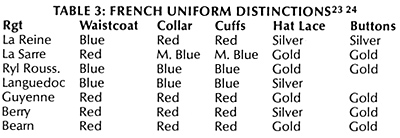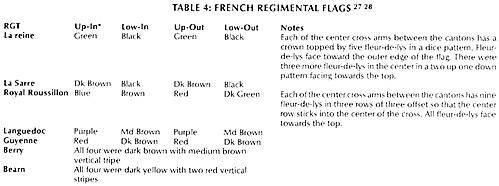 French Line
French Line
The French Infantry on colonial service were issued basically the standard continental uniform and kept the same organization. Each regular regiment, with a number lower than 74, was composed of two and sometimes three battalions. Each regular battalion was formed of sixteen line companies, a grenadier company and a picket company. A battalion was comprised of about 500 men. The basic uniform was a greyish-white coat, white breeches, a sleeved waistcoat (for color see below), and white gaiters. Leather accoutrements were brown. The uniform would have been modified in the new world by the replacement of the sword with a tomahawk (with the possible exception of the grenadiers). Other pieces of clothing would have been acquired as needed. For example, Indian leggings instead of gaiters and perhaps even moccasins instead of shoes. Often in hot weather the regimental coat would be discarded in favor of wearing just the sleeved waistcoat (although this would not be the case at the second battle of Quebec). The distinctions for the regiments involved are shown in Table 3.
French Regimental Flags
The French regimental flags in New France all followed the primary French pattern of 1.78m square with a large white cross in the center. In addition each battalion carried a colonel's flag which would be mostly white, but might have devices on it. For example Knox claims to have almost captured a "White silk flag with three fleurs-de-lys within a wreath or circlet in the center part, and two tassels at the spear end, all of gold". [25] This would most likely have been the Colonel's flag of Royal Roussillon as the device described is also seen on the Royal Standard. [26] I have also seen the Colonel's flag depicted as the same as the regimental flag, but with the white cantons set off from the cross by gold embroidery.

French Colonial Troops
The marines, not to be confused with the shipboard marines, were independent companies raised by the Minister of the Marine to garrison French colonies abroad. They wore equipment and a uniform coat similar to the army. The distinctions being medium blue turnback, waistcoat, and cuffs and medium blue breeches instead of white breeches. Marines are frequently depicted wearing only their sleeved waistcoat and their distinctive fatigue cap (medium blue with yellow lace and anchor symbol). The Cannoniers Bombardiers were marine artillerymen raised to man the cannon in the French colonies. They wore a red waistcoat, breeches and facings and blue coats.
French Militia
There were three brigades of militia in New France: Quebec, Trois Riviere and Montreal. The brigades were little more than administrative units coordinating the calling up of men when necessary. Each parish in a brigade area formed a company of about 200 men (of which no more than half could be called up at any one time). All males between the ages of 16 and 60 were enrolled in the militia. This gave New France some 15,000 men to work with, although the evidence seems to show that no more than 5,000 were ever in the field at one time. The average French militiaman would have worn his everyday clothes. There is no indication that they were ever issued the colored wool caps on a brigade basis that some sources cite.
[29] At least two companies of the militia actually wore uniforms. The wealthier men from Quebec and Montreal wore a scarlet coat and breeches with white cuffs and waistcoat with tricorn hat. [30]
The Quebec Seminary raised a company wearing tricorn, blue capote with white piping and a white sash. [31] There is no evidence that the militia carried flags at either battle of Quebec, although there is some evidence that there was a sort of church banner possibly used sometimes. [32]
All regiments in New France had turnbacks the same color as their coats. Gold and silver lace should be yellow and white respectively on enlisted ranks. The drummers of La Reine wore red coats, collars, turnbacks and cuffs with blue and witie lace. Drum rims were blue and white alternating diagonal stripes. The remaining battalions' drummers wore blue coats, red collars, turnbacks and cuffs with red and white lace. Drum rims were blue and white, red and white or all red or all blue.
[1]F. Downey, Louisbourg: Key to a Continent, Prentiss Hall, 1965.
FOOTNOTES
[2] G. Donaldson, Battle fora Continent: Quebec 7759, Doubleday, 1973.
[3] The French elite troops were formed into a flying column, under Bougainville, which paced the British fleet up river from Quebec. Bougainville's column arrived on the Plains of Abraham after the first battle was over, too late to intervene.
[4] Control of the water was control of heavy transport; the roads in New France were poor at best. Any serious French attack would need to rely on the river to move guns and supplies.
[5] Major-Gen. R.H. Mahon, Life of General the Hon. James Murray a Builder of Canada, John Murray, London, 1921. There were 10 companies, 8 from the line battalions and 2 companies formed by the CFdIM.
[6] Mahon, op. cit.
[7] Tom Harris, An OB for the French in the New World during the SYW, Seven Years War Association Newsletter, Vol. 3, No. 2, William Protz, December, 1986 and Midwest Wargamers Association Newsletter, No. 26, Hal Thinglum, March-April 1987.
[8] E.P. Hamilton, The French Army in America, Museum restoration Service, Ottowa, 1967. Hamilton states that there were about 100 regular artillerymen with the French Army.
[9] H. Bird, Battle for a Continent, Oxford University Press, 1965.
[10] J.A. Houlding, Fit for Service, Clarendon Press, Oxford, 1981. Houlding states that when the battions of the 60th Foot were raised in North America and they were ordered trained in light infantry tactics. The 78th was a Highland regiment (Fraser's) and would also have been expected to be able to act as light infantry. (THEME EDITOR'S NOTE: Some sources state that only one battalion of the 60th was light infantry trained; the 7st/60th under Bouquet - BILL PROTZ)
[11] The men for the light infantry were drawn from the line battalions.
[12] R. May, Wolfe's Army, Osprey, 1974.
[13] Mahon, op, cit.
[14] Houlding, op. cit.
[15] The difference is mainly due to a natural tendency to overestimate the strength of the enemy. Officially DeLevis only has 352 non-combatants on the rolls, however he was planning on substantial help from the disarmed locals for construction of siege works.
[16] Mahon, op. cit., remarks that Chevalier Johnston's account is inaccurate as he describes the Highlanders (th 78th was on the far side of the line) and the French grenadiers coming to grips. (THEME EDITOR'S NOTE: Possibly not. A French map I have seen indicates that the French grenadier battalion was split. Five companies of the ten are shown near the 78th. - BILL PROTZ) However since Johnston was a Jacobite and a veteran of Colloden, I tend to believe that the light infantry by this time had ahigh proportion of Highlanders in it, This is borne out by the fact that the British origianlly raised the Highland regiments to function as the army's light infantry. This would also help to explain the apparently higherattrition of the 78th vs. the rest of the garrison (i.e., the main body of the 78th was down 2/3 of embarkation strength vs. 1/2 for the line regiments). If the light infantrymen were being sent back to bolster their regiments and the Highlanders were replacingthem then this difference is easily explained (especially considering the high casualties the 78th suffered earlier assaulting Beauport Heights).
[17] This seems a bit high, but may include all casualties includingthose soldiers who returned to hospital at the end of the battle and losses from the previous days. At any rate Murray's returns for May 21 indicate that the garrison only lost about 900 fit men total, numbers in hospital have increase by 550 and the numbers killed or captured was about 330. Some of this is due in part to soldiers recovering from sickness during and wounds during May. Also during this time the city was under siege and scurvy was breaking out (which would increase the sick list).
[18] DeLevis reports 84 officers and 534 men killed or wounded from the regular units. He reports 12 officers and 203 men of the militia lost. The militia losses seem low given that they comprised 40% of the French forces engaged, but given the militia preference for fighting prone, the difference is not unreasonable.
[19] Mahon, op. cit. This is quite naturally an exaggeration. DeLevis only reports another 200 men lost during the siege.
[20] Donaldson, op. cit.
[21] When DeLevis retreated he left behind 34 guns (1 x 24lb., 4x 12 lb., plus most of the guns captured in the battle, 6 mortars and 4 petards). Mahon, op. cit.
[22] May, op. cit.
[23] R.D. Pengal and G.R. Hurt, French Infantry Regiments: 7740-7762, March 1982.
[24] F. Funcken and L. Funcken Arms and Uniforms: The Lace Wars, Ward Lock, London, 1977.
[25] Martin Lange, Bill Protz and Bill McHarg, Canadian Militia and French Flags in North America During the French and Indian War, Seven Years War Association Newsletter, Vol. 3, No. 3, William Protz, March, 1987.
[26] Funcken and Funcken, op. cit.
[27] Pengal and Hurt, op. cit.
[28] Funcken and Funcken, op. cit.
[29] For wargamers wishing to distinguish French militia units one source speculates that the cap colors were supposed to be Quebec: Red, Montreal: Blue, and Trois Riviere: White.
[30] Doug Carroccio, Canadian and American Militia Uniforms During the French and Indian War, Seven Years War Association Newsletter, Vol. 3, No. 3, William Protz, March, 1987.
[31] Carroccio, op. cit.
[32] Francis Taurand, French Militia Flags in North America, Seven Years War Association Newsletter, Vol. 2, No. 4, William Protz, December, 1985.
Back to Table of Contents -- Courier Vol. VIII No. 6
To Courier List of Issues
To MagWeb Master Magazine List
© Copyright 1989 by The Courier Publishing Company.
This article appears in MagWeb (Magazine Web) on the Internet World Wide Web.
Other articles covering military history and related topics are available at http://www.magweb.com